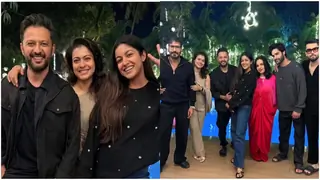Real life makes a surprising comeback on the general entertainment channels. When TV producer Rajan Shahi launched the unusually titled Sapna Babul Ka… Bidaai on Star Plus with Agra as the backdrop, little did he know that a) he had a hit on his hands, and b) he was setting a trend by bringing stories from small-town India to the forefront of Hindi general entertainment television. For some time now, Bidaai has ruled the TRP charts as Hindi GECs' number-one show. It tells the story of two sisters — one fair and pretty, the other dark-skinned. Pleased with the success of Bidaai, Star Plus gave Shahi another prime-time slot, for which he wove a story set in Udaipur to launch Yeh Rishta Kya Kehlata Hai — and delivered another hit for Star. Shahi, who directed Jassi Jaisi Koi Nahi for Sony earlier and set up his own production company, Director's Kut, less than two years ago, likes to believe that after the success of Bidaai, television channels turned their attention to audiences in small towns. Sheel Kumar, executive producer at Shreya Creations, may or may not give credit to Bidaai for the trend, but he admits that "Television programming has moved beyond Dahisar and Borivali." For many years, Mumbai and Gujarat have dominated the stories. "Now serials are going regional and looking beyond the big towns for the 'real' feel," he observes. "Smaller towns are the new landscape for dreams and aspirations. They allow TV to paint a wider canvas of contemporary India," says Sunil Lulla, CEO, Real, explaining why tier II and tier III towns are a sudden hit on the small screen. In a serial on Real, for instance, the female protagonist, an IAS officer, gets posted to Sagar in MP. Another story takes a proud Hindi-speaking girl from Nahan in Uttaranchal to Mumbai. However, it is Rajesh Kamat, CEO, Colors, who modestly claims a share of the credit for having changed the programming texture on Hindi television with the launch of his entertainment channel last year. He says that Colors deliberately steered clear of the metro-centric, upper crust, "saas-bahu" sagas which had ruled the small-screen for eight years. "Scale and grandeur worked for Hindi channels for many years. What's working now is real stories," says Kamat. Based on child marriage in Rajasthan, Balika Vadhu on Colors has the Hindi GEC viewer hooked on weekdays, to make it the channel's top-rated show. Says Balika Vadhu producer Sunjoy Waddhwa of Sphere Origins: "Viewers are ready to experiment. There is no math or formula for serials, but simplicity is back and channels are churning out drama you can relate to." Clearly the current crop of serials, be it on Star Plus, Colors or NDTV Imagine (consider Jyoti by Sunjoy Waddhwa or Bandini by, believe it or not, Ekta Kapoor), are closer to real life, with stories from the non-metros. Palatial houses have all but disappeared and vamps and heroines given way to characters with shades of grey. The focus has shifted from unreal to real drama. "Women are bored with kitchen politics in television entertainment," observes independent consultant Shalini Rawla, who runs the qualitative research agency The Key. The reason behind the change in audience preference is not hard to find. The basic explanation is that the change is cyclical, and that new viewership trends emerge every eight years. Besides, a whole new generation has been added to TV viewers over the last 15 years of private television's existence in India, which is influencing viewership skews. However, others say that small-town stories are popular because they are more aspirational. "In fact, what is happening on television has already happened in cinema, where filmmakers and audiences are open to experimenting with new stories," says Waddhwa. While audience tastes may be changing, new content could also be a smart strategy on the part of the channel owners who know that cable TV is penetrating deeper into the country. TAM data shows a 21 per cent jump in TV homes in the C, D and E socio-economic classes — that is the lower income groups. Besides, TAM, which measures viewership of TV channels, has also included three new markets — Bihar, Assam and Maharashtra (for Maharashtra, towns with less than 1 million population) — which it now tracks. The segments C, D and E contribute 75 per cent of the total population in these new markets. Little surprise, then, that Sheel Kumar is now eyeing Bihar as a constituency for his new story for Colors: "Tentatively titled Reet, it's set in Bihar." Interestingly, Rawla relates "back to simplicity" on TV to the economic downturn as well. Based on her research findings of lower spends on 18 product and service categories such as leisure and eating out, she concludes that people are watching more TV at home. Also, there's the "back to basics" trend her qualitative study has discovered, which shows that people are buying plain vanilla products rather than variants and shifting accounts from private banks to public banks during the slowdown. "There's a sudden reiteration of trust in legacy brands and a veering towards Indianness. I think, around the same time Hindi TV has also moved to the basics." Agrees Sheel Kumar: "Recession is affecting TV viewing. People do not wish to know about the Bajaj family or the XYZ family talking about Rs 100 crore transactions." Shailaja Kejariwal, head of programming at NDTV Imagine, believes that the change in viewership patterns also reflects the maturing of the Indian television entertainment market. Where recently viewers were loyal to channels, now they are loyal to particular programmes. In one evening of TV watching, for example, a viewer may see a show each on Colors, Star Plus and Zee TV, at different times. "Earlier, only one kind of show was working," Kejariwal says. "Now I have the power because I can switch. Viewers are asking for variety." Last but not least, fierce competition is pushing channels to produce better stuff to retain their audience. Needless to say, 20-year-olds are no longer playing grandfathers, camera gimmicks have given way to good writers, and production houses, so they claim, are going all out to audition people in small towns to hunt for suitable characters. "It is a very positive time for the TV industry in terms of people and ideas," says Kejriwal. The good news is that serials will now be finite and not run on and on for years!
|






























